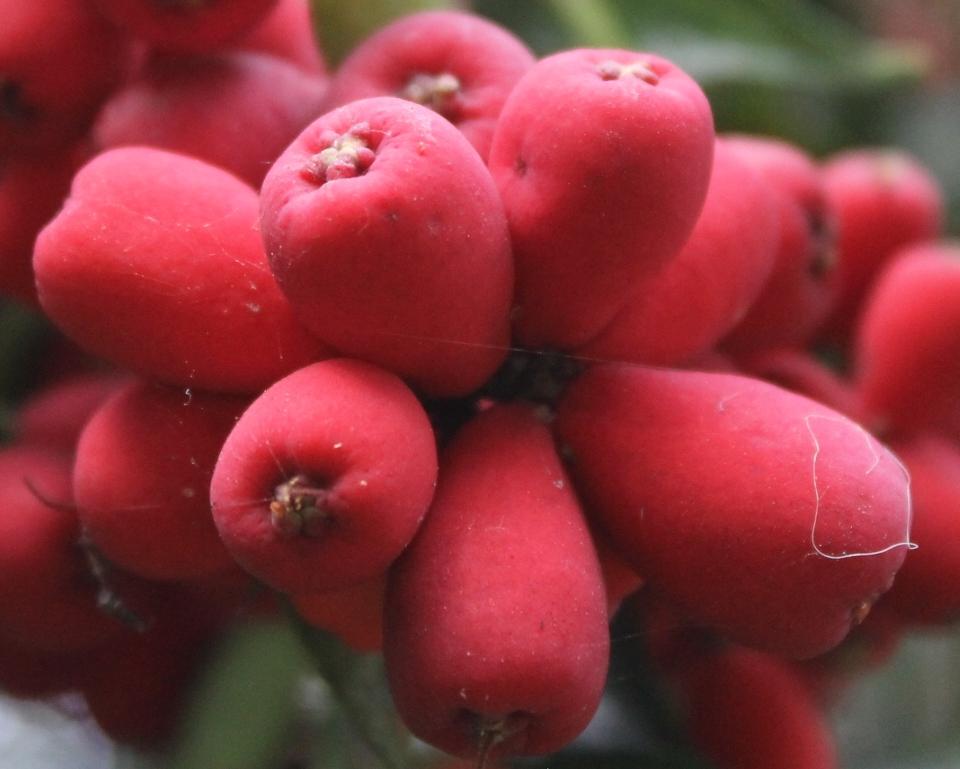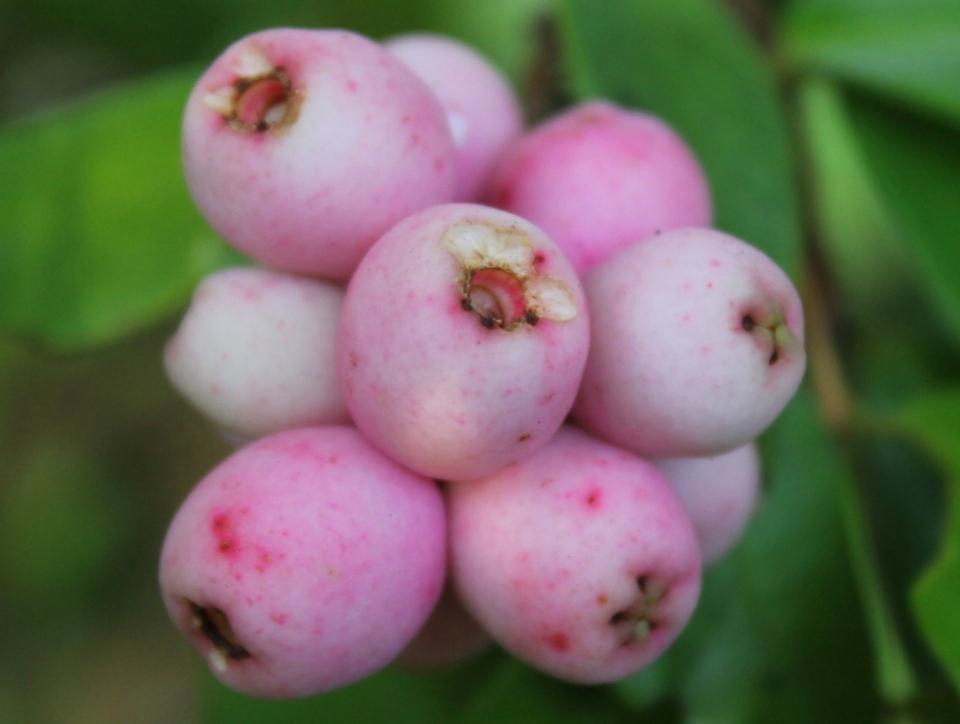February 7 - 13, 2016: Issue 250

Around this time of year we notice trees and hedges heavy with lilli pilli fruit. Having had beautiful jams, tarts and ice creams mixed with wattleseeds made using this fruit, we thought it may be high time to share a few favourites we've used in the past to ensure this Australian native fruit isn't strictly for the birds.
If you’re planning to eat and/or cook with Lilli Pillies, please note that there is a hard little seed in the centre of the fruit. It’s easy to remove the seed by squashing the berry between your fingers. Also don’t use those that grow beside roads and may have car fumes on the skin of the fruit either.
Lilli Pilli jam
A simple rule with jams when using any fruit is once cup of sugar to one cup of fruit whether you're making strawberry, apricot or even marmalade.
Ingredients
1 cup lilli pilli fruits
2 cups water
1 cup sugar
Simmer the Lilli Pilli fruits in water for thirty minutes, to soften the fruit and release the pectin, which helps the jam to set. The color of the lilli pillis will change at this point, but the jam will still turn out a lovely pink in the end.
The Lilli Pilli jam will begin to set after about fifteen minutes of boiling. When the jam has reached setting point, pour it into sterilized jars*. Seal and label the jars when they are cooled. Great on buttered toast or scones or in jam tarts or dressed up with special trims for gifts of something uniquely Australian.
Lilli Pilli Relish
For those who like a nice relish to have with savoury dishes. If you want something a little 'hotter' throw in 4-5 chopped red chillies.
Ingredients
4- 5 cups of fresh, ripe lilli pilli fruit-- if using smaller varieties you will need the 5 cup measure - it is a good idea to deseed fruit prior to cooking to stop any slipping through.
1 large Granny Smith apple, peeled and cut into small chunks
2 cups white sugar
500ml cider vinegar or brown vinegar - depending on preference
1½ tsp salt
5 lemon myrtle leaves or 1 tsp of ground lemon myrtle
1 tbs finely grated ginger, or ½ tsp powdered ginger
Put all ingredients into a pan and simmer slowly for around 2 hours or until the mixture thickens.
Put through a fine sieve if the lilly pilly fruit contain seeds that you haven’t deseeded prior to cooking.
Place into sterilised glass jars* (reuse/recycle glass jars for this purpose).
* Sterilising jars: wash jars and lids with hot, soapy water. Rinse well and arrange jars and lids open sides up, without touching, on a tray. Leave in a preheated 120°C oven for 20 minutes. Or, boil the jars and lids in a large saucepan, covered with water, for 15 minutes.
Lilli Pilli Muffins
Any muffin or cake you make using a berry fruit can be adapted to the Lilli Pilli! This is a standard muffin recipe with Australian Lilli Pillies substituted. Using those that are larger, like the pink version, makes them juicier and it’s easier to remove the pit prior to placing in any dish. You can also substitute seasonal ingredients to celebrate what crop is coming in and at its peak in sweetness and freshness. Always ensure you use those grown away from main roads – you don’t want car fumes all over the fruit’s skin being ingested.
Ingredients
2 1/2 cups self-raising flour
1 tablespoon caster sugar
3/4 cup milk
1 egg, lightly beaten
1/2 cup vegetable oil
3/4 cup brown sugar
1 teaspoon vanilla extract
¾ cup fresh Lilly Pillies – with seed taken out
Preheat oven to 190°C/170 fan-forced. Line a 12 hole, 1/3 cup-capacity muffin pan with paper cases.
Combine the flour caster sugar and brown sugar in a bowl. Make a well in centre.
Add milk, egg, oil and vanilla. Mix until just combined. Fold in lilly pillies
Spoon mixture evenly between paper cases. Bake for 20 to 22 minutes or until golden and just firm to touch. Stand in pan for 5 minutes. Transfer to a wire rack to cool.
Lilli Pilli Apple and Pear Crumble
Adapted from a recipe on Bush Food Shop. A great website with tons of information about Bush Foods and products. See:www.bushfoodshop.com/australia
Ingredients
Peel 7 apples and 6 pears and chop into small chunks.
Place in a saucepan with 60gm sugar and 250ml water. Cook 30 mins.
At the last minute add 100gm lillipillies (riberries). Stir and then transfer the mix to an oven dish.
Rub together one cup of flour and 2 Tablespoons of butter until it looks like breadcrumbs.
Mix in half cup each of brown sugar and rolled oats.
Pat the crumble mix over the lillipilli/apple but do not tamp down too much – you want a crisp top.
Bake at 180C oven for 25 minutes
Serve with ice cream.
Lilli Pilli - a few facts
Syzygium luehmannii is a medium-sized coastal rainforest tree native to Australia. Common names include riberry, small leaved lilly pilly, cherry satinash, cherry alder, or clove lilli pilli.
Syzygium is a genus of flowering plants that belongs to the myrtle family, Myrtaceae. The genus comprises about 1200 species, and has a native range that extends from Africa and Madagascar through southern Asia east through the Pacific.[4] Its highest levels of diversity occur from Malaysia to northeastern Australia, where many species are very poorly known and many more have not been described taxonomically. Fifty-two species are found in Australia and are generally known as lillipillies, brush cherries or satinash.
The habitat is Australian riverine, littoral, subtropical or tropical rainforest. It grows on volcanic soils or deep sandy soils between the Macleay River in New South Wales to near Cairns in tropical Queensland. It is commonly grown as an ornamental tree, and for its fruit, known as a Riberry.
The small, glossy, lance-shaped leaves are a shiny green when mature, but pink/red when young.The fruit matures from December to February, being a pear shaped red berry, known as a riberry, growing to 13 mm long, covering a single seed, 4 mm in diameter. Seed germination is unreliable, complete after 25 days, however cuttings strike readily. The fruit is eaten by the Australasian figbird and emu.
The tree commonly only reaches 8–10 metres in cultivation. The berry has a tart, cranberry-like flavour, with a hint of cloves. It has been popular as a gourmet bushfood since the early 1980s, and is commercially cultivated on a small-scale basis.
The fruit is most commonly used to make a distinctively flavoured jam, and is also used in sauces, syrups and confectionery. It can also be eaten and enjoyed straight off the tree. The riberry plant is also very popular as a garden ornamental and street tree. It is easily maintained as a smaller tree by light pruning.
Syzygium luehmannii. (2015, December 8). In Wikipedia, The Free Encyclopedia. Retrieved from wikipedia.orgSyzygium_luehmannii
Syzygium. (2015, December 8). In Wikipedia, The Free Encyclopedia. Retrieved from wikipedia.org/syzygium&oldid

Lilli Pilli photographs by A J Guesdon - taken in Pittwater, Summer of January and February 2016
Recipe Ideas - Seasonal Fruits and Vegetables
Apricot - January Summer Fruits
Artichoke – The Flower Vegetable that Crops in Spring Australian and Native Cherries (Summer Fruits) - the Duntroon Connection - Marrianne Collinson Campbell Autumn is Apple Season
Cherry - Australian summer Fruit
Chick Pea Burgers with Homemade Hummus
Easter Feast - modern and historic
Green Beans - Spring Vegetables
Hogmanay (New Year) Dinner - Australian Style
Make Your Own Treats For Christmas Gifts - Jaffa Rum Balls, White Christmas, Gingerbread People, Spicy Nut Mix, Strawberries Dipped in Christmas, Scottish Shortbread, Spanish Polverones, Melomakarona (Greek Christmas Honey Cookies), Kourabiedes (Greek Butter Biscuits), Italian Lemon Shortbread Squares (Shortbread con crema al limone)
Mandarins Spring Fruits Mandarins Winter Fruits
Mum's Vegetable Soup with Macaroni
Nectarines - end of Summer crop
Packham's Triumph Pears - The Australian Pear
Parsnip - Winter Vegetables Pear - Autumn Fruits
Potato Gnocchi Pumpkin Pumpkin Season 2015
Sage - the 'saving' herb Remembrance Day 2012 Food
Self-Saucing Winter Puddings Silverbeet - Winter Vegetable
Spring Salad Season Spring Strawberries Spring Salads
Summer Passionfruit Summer Peaches, Quandongs (Wild Peach) - Marian Rowan Ellis Summer Raspberries Native Ones - Adam Forster
Ten Minute Spring Salads - fresh Spring Fare Tomato
Winter Crops Winter Vegetable Pies
Pittwater Restaurants, Cafés and Bistros
Café Edelweiss and the German Butchery at Bassett Street: Mona Vale
Duck Creek Macadamias - Orange Obsessions
Home Grown Food Program in Fruit and Veg Month by Jess Rosman
Laurie Bimson's Marinated Kangaroo Recipe
Lobster Nights at Club Palm Beach
Palm Beach Fish and Chips Tops Scale at 10
Prontos Creative Food - Palm Beach Pronto Creative Food Celebrates 30 Years - Palm Beach Success Story for Local Lady
RMYC Function Food at Rotary Club of Pittwater 52nd Changeover Dinner
RMYC Ladies Lunch for July(2012); 'Boosting Your Brain and turning Your Stress Into Success' by Dr. Helena Popovic
Salt Cove On Pittwater at RMYC Broken Bay
The Avalon On The Beach Restaurant and Kiosk Opens in Avalon Beach SLSC clubhouse

To list your business, have a Pittwater Online News Food page run, or place a logo on the Pittwater Online News Food page, please contact us with details of your requirements.
Logos may be embedded to redirect to your own website.
Full pages include an overview of menus as well as beautiful images to make the food sampled look its best.
Full pages are archived into Permanent pages past their week of Issue.
Permanent pages in Pittwater Online News average 800 thousand visits per annum past their week of Issue ensuring diners will continue to view your eatery as a potential venue for breakfast, lunch or dinner or as the place to hold their larger functions.
For Rates and Packages Contact us at: